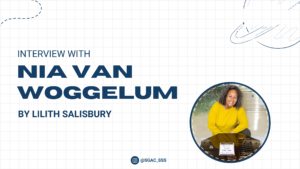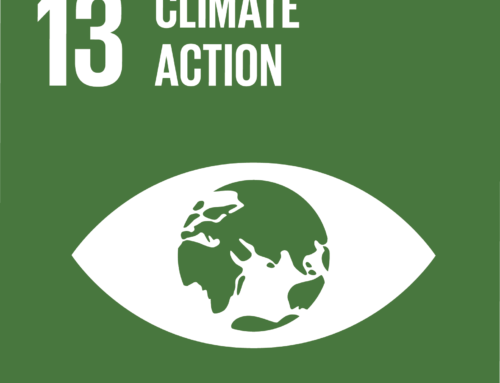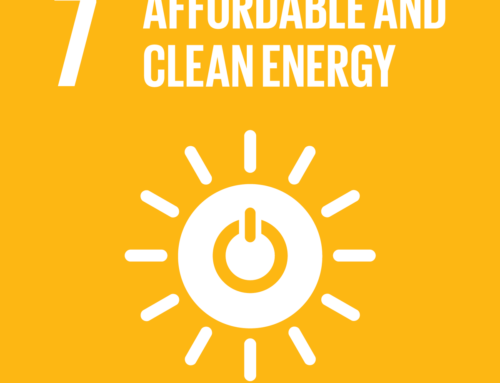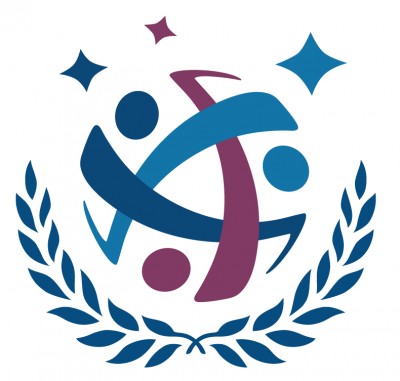In the middle of May, I had the pleasure of interviewing Nia van Woggelum for the first edition of our new interview series ‘Women in Space for Safety and Sustainability’. Nia has over twelve years of experience producing composite products and is currently working as the Manager of Operations at GTM Advanced Structures. We spoke about her career journey, aspects of safety and sustainability that she encounters in her work, as well as her experiences as a woman of color in her field.
How did you find yourself at GTM Advanced Structures?
It started in high school when I found myself really enjoying working with chemicals in the school labs. I was like, this is so cool, I really want to do this. My cousin was studying as a flight attendant at the time, which was not something that I was interested in doing but I found out that at the same school, they were teaching aeroplane construction which had plenty of opportunities for technical jobs for the future. Which I thought was super interesting. At the time I was in that school, the Fokker industry collapsed (a Dutch aircraft manufacturer) so I decided to broaden my horizons from aircraft manufacturing to composite materials as my teachers told me that this was an industry that was going to boom in the future. The same technics of repairs of wings are applicable in the automotive.
I then applied to my first internship at Fokker Papendrecht. That company didn’t end up having a position for me, finally ended up at a small company specializing in injection molding close to home, which created models for all different kinds of industries.
My second internship I got through my aunt who was working for Dutch Space at the time in the canteen (now known as Airbus Netherlands). My Aunt told me that she would ask around, and there was one guy working there who was very willing to take on an intern. This was during my last year of school, where I did investigations on crack forming and PSU material (Polysulfon). They put microbiology organs into a small cube made from PSU material to see how it evolved in space. If you have Polaroid lenses, you can see the tension in the materials. So, I did a study on how these materials reacted. So that was what I did at Dutch Space. I was around 21, and I was like oh when I’m big I really want to work here.
After this, I started work. I found it hard to find a job as just out of school as I don’t have real life experience only an internship. This is what I see in a lot of young people now, they first have to learn what really goes on in the real big world, in the working industry. So, I started at Airborne Composites, and they were a really small team of four people. The first big order we had was creating ambulances with carbon fiber and glass fiber and a foam structure.
Jochem (Nia’s former Managing director at GTM) came to the company and said that he had a big order to create a satellite. It was an Italian customer and he wanted one big dish, from carbon fiber. At that time, we did it with only four people. We moved from Oestgeest to the big hall now in Ypenburg, The Hague, because in that facility there was a big cleanroom and an autoclave that we could use to do the lay-up of the skins and cures. Then we got the next order for 24 of the ALMA ANTENNA. Jochem was the project manager then and we worked together on that project, and he said ‘Nia start getting knowledge. Work at as many big companies as possible, get to know all the people, and then when the time is there come back to me. At the time I think it was around 2009 and I was like ‘Well, we will see what happens’. We always stayed in contact, me and Jochem.
Then I worked on the floor, but then I got pregnant and couldn’t work with all the chemicals. I started working as a work preparator because they said, well you know all the processes, all the materials so you could write everything down. You could prepare everything and do the purchases so that everybody has the right tools at the right time. I told them that it was important for me to have the education for the role because if anything happened while I couldn’t work with chemicals there was nothing for me to fall back on. So, they paid for my education for that, and I did it for a few years, but after a while, I didn’t feel challenged anymore. I asked for a more challenging role, and they said that the only position they had was a project manager. I didn’t want to lose the affinity with the workshop, so I decided after six years that I would let it go.
After this, I began working in a wind blade manufacturer also in R&D. It was for building molds with heated wire insure so that you could cure the material in the mold, and it wouldn’t need to go into an oven, and nothing would need to be built around it. I worked there for three years, and they had projects in India and China. However, the company didn’t survive so I was forced to find another company to work in.
After this, I began working at an American company called Elements Materials Technologies. They do a lot of testing. They bought a lot of smaller labs in the Netherlands, they have several. So, I started working there as a work preparer and I told them that if I wanted to do the work the best way, I needed to really understand how everything worked. So, I went to go on an internship with all seven labs. I always said, okay you can plan stuff, but if you don’t know how it works how can I manage the people that need to get the work done? How can I push them to get results? So, I went on the internship, and I learned how the test machines work and that is also a part of what I do now here at GTM. But then I decided I missed working with all the materials in the aerospace industry. So, I went back to that.
I worked with a lot of different companies during this time, one of them built parts for bridges from glass fiber. That was what we built for the city of Rotterdam. I brought the kids and said, look, Mommy built the bridge! That’s the thing. These projects take a lot of effort, but in the end, you can see a physical result.
After this, I worked in the ISIS space as a production coordinator. The team there was working really hard all together and making a huge team effort to get all the satellites they needed to make put together. We had to work really hard to get those satellites put on the Falcon 9. What I learned from this is that you need each other in a team to get the work done. You can’t do it alone. The team was so important. It is also a lot of stress, so you need to be able to rely on each other. You cannot work by yourself as an island. That was something I saw in all the companies I worked at, including GTM. You really need the team to get a good end result.
Working at ISIS space, I got a lot of knowledge and met a lot of people to expand my network. I looked on the Airbus website and saw an opening, and I was like yes that’s my dream job! I was so happy. They were searching for a work preparator. It was a new position that had been created and they didn’t really know what they needed. When the company still was part of Fokker Space they use to have a whole department with work preparation. Because of the multiple reorganizations the position work preparation disappeared, It was my dream job, but I fell hard on my face a lot of times there. I learned a lot at the company. I found out there what it was like to work in companies in a male industry. I had a really great experience there, working on a lot of big projects and working with great people. There were two girls in our department. I worked for 3 or 4 years at Airbus on the instrument SPEXone for NASA, and I feel like I accomplished a lot. They had never had a team dinner with the AIT department (Assembly, Integration & Testing), so I organized it. I made a schedule of when everyone was traveling so I knew a week when everybody would be there. I really enjoyed that. It was really great.
I left Airbus during COVID times which was quite difficult of course. The project manager at AIRBUS had been very happy with my work so he said that there was a position open at TNO, maybe you can apply there. It was close to home, and I was working from home with the kids off school, so it worked well for me. As it was close to home when I needed a clean room, I arranged a babysitter for the kids, and it was so much better. We were working on the NorSat satellite.
During this time, Jochem came to me and said I see you have a lot of experience now, I think it is the right time for you to come to my company. I was a contractor at TNO, so I negotiated with Jochem based on that and now that the girls were a lot bigger, I felt able to move to work somewhere a little further away from home. I really like the area of the office. Cycling there is really nice and fast. There is a bit of nature around as well.
What is the makeup of the team at GTM? We discussed that some of your previous teams didn’t have many women on.
We have me, and a working female student here. She started in 2021 as a holiday job, but she is traveling at the moment. The last woman who worked here before us was 14 years ago as a receptionist. They didn’t have any women in the workshop. Our team is really small, though. 8 people in total including the working students. Mostly we do now are small R&D projects and investigations. Our core is testing and selecting materials with the customer, and we do the whole A to Z with the customer. From the design, selecting materials, and creating the product for the customer to their wishes and requirements for aerospace. It is very much a team effort. Everybody is very close now. Together we create something great.
I also always say I’m a spider in the web. I think being a mom really helped me with that. I have to be able to coordinate at home, so I can do it at work really well. That helped to manage people, and manage time, I am good at organizing and planning stuff. When I became a mom, I was like oh, I know how to do this.
Is there anything that GTM considers in terms of sustainability in its operations?
I am not really involved in talking to the customer. I am not really involved in the sustainability part, but we definitely do consider it here at GTM. We take into account what kind of materials we buy not only for the products we build but also for the ‘auxiliary materials we use to build the products’ think of the gloves we use or the wooden mixing spoon for the resin and adhesives.
Do you have any general safety considerations that you undertake at GTM, especially with the company ramping up production now?
With adding new people to the team, we create pads and a safety plan and also ensure that everything we work with is used according to safety regulations. Everybody is trained to work with all the chemicals and machines we use. Everything is done step by step according to the regulations.
How have you found your experience as a woman in the workplace over the years?
When I was young, I was always told that because you’re a girl you will have to work twice as hard in a man-dominated technical industry. I was born in the Netherlands, but my surname is not Dutch. My parents are from Indonesia and my skin color is different, so my dad always told me that I would have to work twice as hard as anybody else and I didn’t believe him. Not because I’m a woman, but because I’m from a different country. People won’t see you and go ‘Oh, that’s a Dutch girl’. They will see you and think, that’s a woman of color. My Dad always told me that and I thought, oh, whatever. It’s not really that way. But I found out the hard way that it is like that. People will judge you and think that you aren’t experienced. Oh, she can grow.
In a meeting a few years ago, I was coordinating all the parts for an instrument that we were creating according to the drawings and then there needed to be a surface treatment. When the parts came, they had really weird spots on them. The project manager said to me, Nia, you coordinated the design with the purchasing department. Can you go to the company and ask what happened? Why are there spots on the material? I went with one of my colleagues from purchasing as he made the contract with the supplier. I went to the company, and we sat down at a table, and I was looking in my bag for the drawing. People started explaining technical details to my colleague. He had to say to them, you have to talk to her I’m just from purchasing. The guy went red in the face. He said oh, sorry, because he thought I was from purchasing and he was for the technical details. No, I’m the engineer. You have to be with me. I did like the way he spoke up. I liked that he said, no, you should be talking to her.
For my girls, they don’t see it like that, and they don’t experience it. I’m really happy that they don’t and that I walk this path for them. I’m happy that I got these reactions on my name, on my skin color, and working as a woman as now I think there is a lot more awareness of the bias. When I was younger, I was the only one in the aeroplane construction. I didn’t have a different locker where I could change. All the guys would wait outside, and then I would change into my overalls on my own. The guys could only go inside once I was done. If I would go back there now, they would have a locker for women, but they didn’t at the time. There is a big change, and I am happy to see it.
One thing that I learned a lot through working at lots of companies was that it is very important to be mindful of the difference in cultures in the workplace. I have worked with people from China, India, Ukraine, French Guiana, and everybody has different and interesting backgrounds, as well as a different approach to work ethic. I loved working in these teams. We were working so hard, and also sometimes at the weekends, so I tried to organize some dinners and brunches with the families as I understand that it has an impact on the family if the father or mother has to work on the weekends. It is very important to have that people’s knowledge. Definitely. That was one thing that I really learned – if you treat people with respect, they will treat you with respect back.
Another thing I have learned is that the industry is all about connections. If I have a problem, I have so many connections now that I could reach out to and ask for help. When I was younger, I had issues working as a young woman without experience in the space industry. I think it made me stronger. All the rejections. Lots of people now are surprised by my experience. They see me and think I am a lot younger. It is very funny to see!
In the beginning, I also covered up my tattoos. I didn’t talk a lot about my kids. I really wanted people to take me seriously. Then I felt like I was selling myself out because that was not who I really was. I knew I could do the job. You only need one person who believes in you, and then you can handle the whole world. I really got my confidence from that. I really felt like I was able to be myself once one person started believing in me and seeing that I did good work. I wouldn’t cover up my tattoos, I was like this is me!
If you could say one thing to yourself when you were starting to decide to go into the space industry, what would you tell yourself?
Just to motivate yourself. Don’t be insecure because you’re a girl. You can do this. If a man can do it, you can do it. This is how I raise my daughters now. They always say, oh mom’s so feminist. You can do anything no matter what and you always have to just try. Just try. Before you say you can’t or that you won’t do something. That is always a good mindset to have. It is a hard world. If you work in another industry, it’s just the same.
Interview and article by Lilith Salisbury









